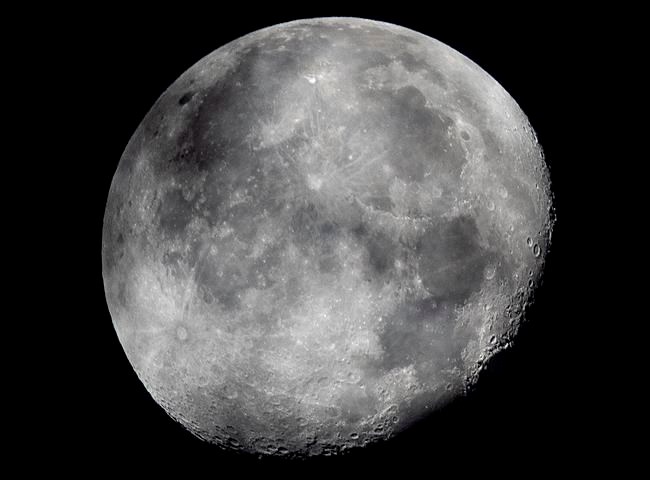OTTAWA — The federal government has signed an agreement with the United States to send a Canadian astronaut around the moon as part of a broader effort to establish a new space station above the lunar surface.
Industry Minister Navdeep Bains unveiled the new Gateway Treaty on Wednesday, which formalizes Canada’s involvement in the U.S.-led effort to build that new station known as the Lunar Gateway.
The treaty includes a commitment to having a Canadian on board when the U.S. conducts a manned flyby of the moon in 2023, as well as a second yet-to-be-scheduled flight to the future station.
“Canada will join the U.S. on the first crewed mission to the moon since the Apollo missions,” Bains said during a news conference with Canadian Space Agency astronauts Jeremy Hansen, David Saint-Jacques, Joshua Kutryk and Jenni Sidey-Gibbons.
“Launching in 2023, a Canadian Space Agency astronaut will be part of Artemis 2, the first mission to carry humans to lunar orbit in over 50 years. This will make Canada only the second country after the U.S. to have an astronaut in deep space.”
The new treaty also formally confirms that Canada will contribute a new robotic arm to help with construction of the Lunar Gateway, which will orbit the moon and allow for exploration of the lunar surface and assist future missions to Mars.
The government last week committed $22.8 million toward development of the new Canadarm3 by MDA Canada.
The Canadian Space Agency is one of several partners in the U.S.-led endeavour along with the European Space Agency and their Japanese counterpart. Russia has also expressed an interest in joining.
The Lunar Gateway is projected to be about one-sixth the size of the International Space Station in orbit around the Earth, with plans to build it over the next decade.
Bains did not say how much Canada will spend to participate in the Artemis 2 flight, which will come after an unmanned flyby of the moon that the U.S. has scheduled for next year.
“It's important to note that we're a spacefaring nation, and very proud of our space history,” he said. “And this investment with regards to the Artemis 2 program, as well as the overall space strategies, is well over $2 billion over the next 24 years.”
Bains later said in an interview with The Canadian Press that the two flights as well as the Canadarm project and other robotics programs on the Lunar Gateway are included in the nearly $2 billion set aside for space.
The minister defended Ottawa’s planned investment in space, touting the economic and scientific benefits that come from Canada’s involvement in extraterrestrial exploration – a sentiment echoed by some of the astronauts in attendance.
MDA president Mike Greenley made similar comments in an interview following the announcement as he welcomed the new treaty with the U.S. as a win for Canada’s robotics sector and space industry.
“And then the astronauts' flights are highly, highly motivational for the rest of the country,” he added.
“It’s been clearly demonstrated that the motivation of youth to pursue careers in science, technology, engineering and math and STEM professions has been inspired by astronauts in the space program, is high. And so you're driving the next generation.”
As for the purpose of the Artemis 2 flyby, Kutryk said it will help test the rockets and other systems needed to start work on the Lunar Gateway.
“It's worth pointing out here that this will be, I think, the farthest and fastest that any human in the history of our species has ever gone,” he said. “And so it's a very big deal to be able to do just that: get a vehicle that far away and then safely recover it back to Earth.”
They also spoke about the excitement and interest that is generated among young Canadians who may be encouraged to pursue careers in robotics and other areas with potential links to space.
Exactly who will get to fly past the moon has yet to be determined.
“At some point, we will assign a crew and that's when we'll find out which Canadian astronaut is going to be selected,” Hansen said.
“One of the things that's really important to us as an astronaut corps is the word ‘team,’ and that we take on these big challenges together ... and it doesn't turn into a competitive process, but turns into a process of us lifting each other up all the way.
One of the main drivers in the U.S. plan to get back to the moon has been Donald Trump. Bains suggested the president’s imminent departure from the White House next month after losing the November election to Joe Biden does not threaten the program.
“We'll continue to remain engaged with the Americans,” he said. “But so far, all signals have been positive and we've heard nothing to the contrary. There's a great deal of commitment to this program. And I believe it's bipartisan.”
While Artemis 2 will not touch down on the moon, the U.S. has plans to land a ship on the lunar surface in 2024.
Bains would not rule out a Canadian being on that trip as well, saying: “Conversations are ongoing, and I wouldn't necessarily close that door yet.”
This report by The Canadian Press was first published Dec. 16, 2020.
Lee Berthiaume, The Canadian Press



